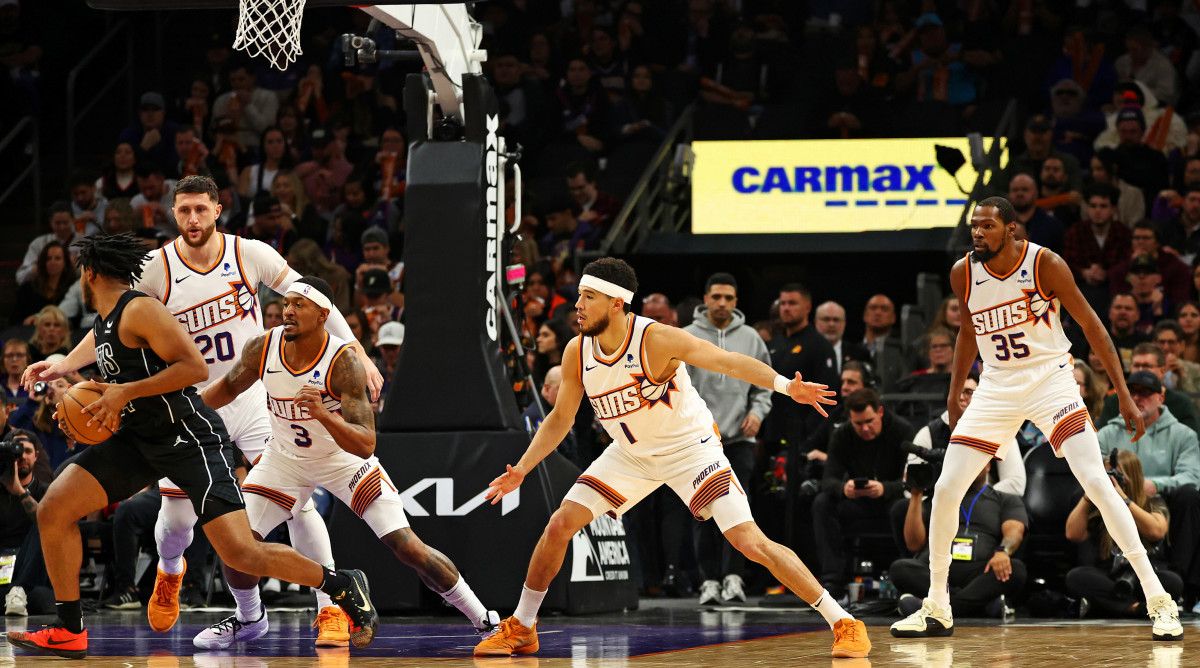The Debut of the Suns’ Big Three Proves the Combination Is Still a Work in Progress
Over a quarter of a way into the season, the Suns’ trio of Kevin Durant, Devin Booker and Bradley Beal finally made its debut Wednesday in a 116–112 loss to the Nets. Here are three takeaways from the first night of the Durant-Booker-Beal experiment.
1. The star stagger was staggering. To get a sense of Phoenix’s top-loaded roster, with its three stars available, the minute totals were still very high. Durant played 38, Booker played 40, and Beal played 34—the latter two doing so on the second night of a back-to-back and, in Beal’s case, on just his second game back from a back injury. In the 19 minutes the three stars played together, the Suns were a whopping plus-12, with a 23.6 net rating. That’s great! The issue for Phoenix is it was a minus-20 in the eight minutes Booker was off the floor.

Figuring out how to best separate the three stars between tip-off and the final few minutes will be priority one for Frank Vogel moving forward. With Durant and Beal, the Suns shouldn’t be so bad when Booker rests. Unlocking the right combination there will not only help the team be even more formidable, but it will also help Vogel better manage the minutes of what’s been an injury-laden group so far this season.
2. The closing group is a work in progress. Outside of the three stars, Vogel will also have to figure out all of whom to best finish games with. On night one, Vogel tried a couple of looks, including a traditional one with Jusuf Nurkić at the five and Jordan Goodwin in the backcourt, as well a small configuration with Keita Bates-Diop in place of Nurk. How the finishing groups unfold for Phoenix will be fascinating to watch. The Suns can struggle to get stops at times when talented wing players target Nurkić; Spencer Dinwiddie went after him on a switch late in the fourth and got an open pull-up three, and, later, when Pheonix went small, Dinwiddie took advantage of the lack of rim protection, blowing by Bates-Diop for a layup. Who are the players that can offer enough defense without being total zeros offensively? That’s a central question for the Suns, considering late in games teams will ignore role players to send extra bodies at Durant, Booker and Beal.
3. Where will the threes come from? Phoenix made only nine of 28 threes Wednesday. For reference, the Magic connect on and attempt the fewest threes per night, at 10.0 and 29.3, respectively. Look, a one-game sample size obviously isn’t a tell-all. But it’s no secret that the Suns’ stars have a proclivity for the midrange. At the same time, with all the attention paid to them in the half court, Phoenix should eventually be able to generate open looks from the outside. Whether its players are prepared to knock them down remains to be seen, though getting Grayson Allen back should certainly help in that regard. It will definitely be surprising if the Suns struggle offensively: They still had a 117.9 offensive rating Wednesday despite the lack of outside shots. It never hurts to help tilt the math more in your favor, though.
